sideblog to post all my bug pics! if you make a cheeky comment like 'kill it with fire' on any of these beauties I'll rip out you kidney (and block you)
Don't wanna be here? Send us removal request.
Text
Wet Beast Wednesday: crayfish
It's week 3 of fresh-uary, the month where I only cover freshwater species for Wet Beast Wednesday. This week's topic is the crayfish, also known as the crawfish, crawdad, mudbug, lobster, yabby, kōura, and a lot of other names. The various names for crayfish are also applied to a variety of saltwater species that aren't the topic of today's post, so there's some confusion over terminology when discussing these creatures. Let me clear some of that up and explain why it's ok to be cray.

(Image: a red swamp crayfish (Procambarus clarkii), seen from the side. It is a long, lobster-like crustacean with a rigid front half and flexible tail ending in a wide fan. It walks on 8 legs and has a large pair of pincers held in front of the body. The head ends in a pointy snout with two eyes on short stalks and two pairs of antennae. This one is mostly red, with darker portions on the back. End ID)
The crayfish I'm covering today are freshwater members of the clade Astacidea. This clade also contains clawed lobsters, so there is a lot of similarity between the two groups. There are four families of crayfish, split between two superfamilies. These families are largely split up by region. The superfamily Astacoidea are known as northern hemisphere crayfish and contains the families Cambaroididae (found in eastern Asia), Astacidae (found in west Asia, Europe, and Western North America), and Cambaridae (found in eastern North America). The superfamily Parastacoidea, or southern hemisphere crayfish, contains the family Parastacidae, members of which live (or used to live) in South America, Madagascar, and Australia and New Zealand.
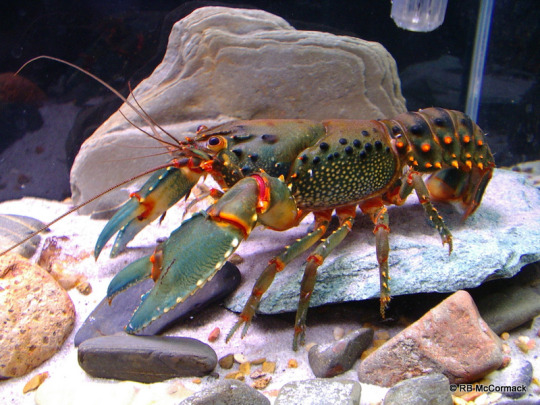
(Image: The Sydney spiny crayfish (Euastacus spinifer) seen from the side. It is a dark green in color, with orange outlines and orange and black spines around the body. End ID)
Crayfish are very similar to clawed lobsters in appearance and have a fairly typical decapod body plan. Their bodies consist of 20 segments grouped into two main body parts: the cephalothorax and abdomen. The cephalothorax is rigid, covered by the carapace, and contains the head and attachments for the legs. The head includes two stalked eyes, two sets of antennae, and a sideways opening mouth surrounded by leg-like maxillipeds that help manipulate food. As a decapod, crayfish have 10 legs. Like their clawed lobster cousins, crayfish use four pairs for walking while the front pair have been modified into a pair of large pincers used for defense and capturing food. Lost limbs can be regrown, though it takes a while. The abdomen forms the flexible "tail". Each segment of the abdomen contains a pair of appendages called pleopods or swimmeretes. These help circulate water and can be used to swim in juveniles. In males, the first pair of pleopods is modified into grasping structures used to hold onto the female during mating. The abdomen ends with a fan-like structure called the telson, that acts like a fin. By rapidly curling its abdomen beneath it, a crayfish can shoot backwards away from danger. The largest species of crayfish, and largest freshwater invertebrate, is Astacopsis gouldi, the giant Tasmanian freshwater crayfish. It can reach 80 cm (31 in) long and 6 kg (13 lbs), though such large individuals are rare. Most crayfish species are considerably smaller.
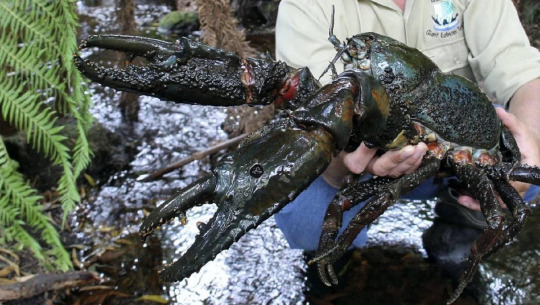
(Image: someone holding a giant Tasmanian crayfish up to the camera. It is extremely large for a crayfish, requiring two hands to hold and its pincers are roughly as long as the person's hands. It is a dark, swampy green to black in color, with many small lumps on the body. End ID)
Crayfish are benthic omnivores and detritovores found in both running and still water. Crayfish are opportunistic feeders with extremely varied diets that include plants, fungi, animals, microorganisms, and decaying organic matter. Mist species are considered primarily herbivorous and scavengers, though they will take live prey if the opportunity arises and have been known to be cannibalistic. Decomposing organic matter forms a large portion of the crayfish diet and they often eat it through the mud and slime found on the bottom of their habitats. A crayfish can quickly swallow mud, then internally sort it by the size of ingested particles. Coarser materials are processed and excreted faster. The digestive tract can process the dead plankton and decaying organic matter that makes up mud from the sediment. Feces are excreted wrapped in a peritrophic membrane. This membrane is rich in proteins and is usually eaten by the crayfish to regain them and get a second shot at digesting organic matter in the feces. Fresh vegetation is also a major food source and there are even reports of crayfish leaving the water to graze on land plants. Crayfish feed periodically, switching between periods of feeding and periods of hiding while they digest. As with all crustaceans, crayfish have to regularly molt their exoskeletons as they grow. They typically eat their old carapaces to regain the calcium carbonate and other molecules contained in the shell. After molting, it takes time for the new exoskeleton to harden, leaving the crayfish more vulnerable to injury or predation.

(Image: a small, orange crayfish in captivity inspecting a cucumber slice that is being offered as food. End ID)
Crayfish mate seasonally, usually in spring through late summer, triggered by changes in water temperature. The exact mating process depends on species, though females are likely to release pheromones to attract males. Males are initially aggressive, but often calm down sometime before mating. Males are known to fight over access to females. In some species, the male and female will touch claws and exchange chemical signatures prior to mating possibly as a courtship ritual. Males have also been seen attempting to mate with other males. Once a female accepts a mate, the male will flip her onto her back and align their abdomens, using his modified first pair of pleopods to grab on. Once their genitals are aligned, the male will pass a sac of sperm to the female using structures called gonopods. The male will leave after mating. The female lays clusters of eggs that are carefully attached to the pleopods. Until the eggs hatch, the mother will carry them with her, moving her pleopods to circulate water around them and using her legs to clean them. Egg development can takes days to weeks depending on species. The young are born well developed for crustaceans, looking like miniature adults. The female will shake her pleopods to help the hatchlings emerge. Juveniles are at a high risk of predation, including from other crayfish, so only a few of the possible hundreds of eggs will reach adulthood. It can take years for a crayfish to reach sexual maturity.
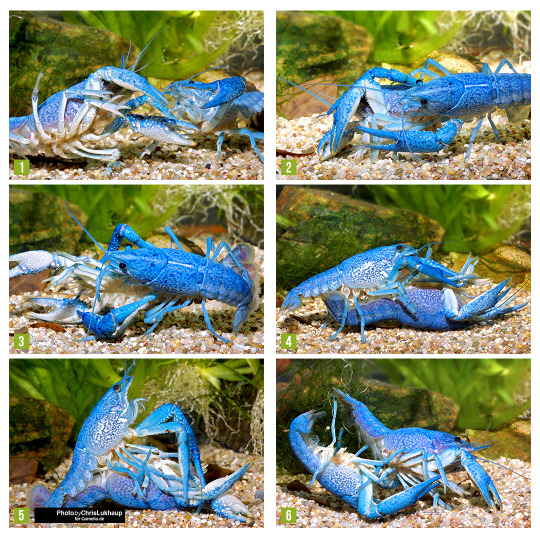
(Image: a series of 6 photos showing two blue crayfish mating. In the first three photos, the male turns the female on her back. In the 4th photo, the male starts to line up his abdomen with hers. In the 5th photo, the abdomens are aligned and mating is occurring. In the last photo, the male climbs off of the female. End ID. Source)

(Image: a female crayfish being held upside down to show her eggs, visible as small, black balls attached to the underside of the abdomen. End ID)
Crayfish are edible and eaten worldwide, with 95% of the world supply coming from China. Boiling is the most common form of cooking. Experiments have shown that crayfish take a while to die when boiled and show pain responses. They also release cortisol, a stress hormone, when boiled. There is, for some reason, a debate on whether or not crustaceans can feel pain. I think that it's obvious they have negative responses to negative stimuli and therefore it can be safely assumed that they can suffer. To more humanely cook a crayfish, freeze them for a few hours to render them unconscious, then cut down the body lengthwise to destroy the nervous system before boiling. Crayfish are also kept in aquariums as pets and can be fed shrimp pellets and plants, but they may also try to eat other organisms in the same tanks. In the wild, many species of crayfish are threatened by overfishing, habitat loss, climate change, and pollution. Most species need clean water and are highly vulnerable to pollutants. This allows crayfish to be used as an indicator species for the health of their environments. The pseudofungus Aphanomyces astaci causes a fatal disease called crayfish plague that has escaped from aquacultures to affect wild populations. Side note, I had no idea pseudofungi were a thing until right now. Multiple species of crayfish have become invasive species after accidental or intentional release of common food species. Other invasive species can outcompete or prey on native species.
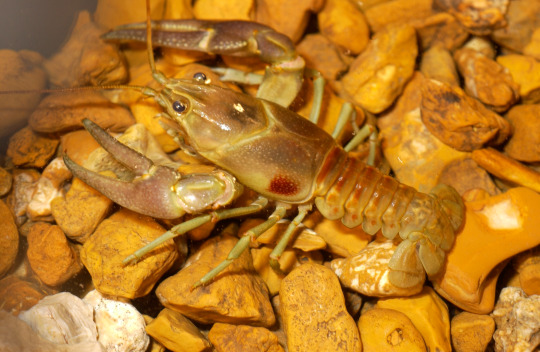
(Image: the rusty crayfish (Faxonius rusticus), a common invasive species in North America, identifiable by the rust-red blotch located on the sides of the carapace near the rear of the cephalothorax. End ID)
102 notes
·
View notes
Text

BEWARE THE TUSSOCK CATERPILLARS!
why did nature have to make you so cute and fuzzy and then make you untouchable
0 notes
Text

One thing I miss about the trailer I rented was the abundance of mantises that lived there.
The new owners cut down most of the bushes, foliage, and trees though so I doubt they live there anymore. :(
1 note
·
View note
Text

Tired little friend taking a break
0 notes
Text


LOOK AT THEM LEGGIES
so rare to see a harvestman with all his legs still
#identified#harvestmen#spider#even though it's not actually a spider#daddy long legs#amateur identification
0 notes
Text
In Norway we celebrate christmas eve more than christmas day, so today is christmas for me. I’m writing this before our christmas dinner. I want to say it has been a good but tough year, and today I’m thinking of my friends in Gaza. It has been an honor and a gift to be allowed to help and be in contact with them, but terrifying to hear their stories and know how much danger they face every day. For the new year, I wish them safety and peace, and I hope that whatever holiday you celebrate, you can be willing to help them this year. That is my wish
I’m sharing their fundraiser again in the hopes that you can show them some love and support
Nader @abdalsalam1990, my friend who i’ve known the longest, a 17 year old who campaigns daily to save his family including his father who is sick with cancer and his 1 year old niece. His strength, kindness and hard work to provide for his family impresses me every day. (Vetted #4)
Ibrahim @wolf-aid A 15 year old boy with hopes and dreams of continuing his education, but now has to struggle to survive every day so that he can get his family to safety and achieve his dreams (Vetted #25)
Ahed @ahedfamily A 33 year old father of three young daughters under ten, who loves his daughters so much and spends all his time trying to get them to safety and get his daughter medical treatment she needs. He has a kind heart and helps other people, even when he needs help so badly too (Vetted #229)
Ghada @ghadaanqar A 32 year old man with a bachelors degree and a great job and a promising future, whose career was taken from him by the bombings. He provides for many other people, despite this. (Vetted #6)
Hani @haniyassersposts Hani is a young palestinian with a degree in social work and dreams of helping others and making a difference in his community. He has always shown me kindness and hope, even in his horrible circumstances. (Vetted #5)
I hope you will share this post and donate to help them, they really need and deserve help
4K notes
·
View notes
Text


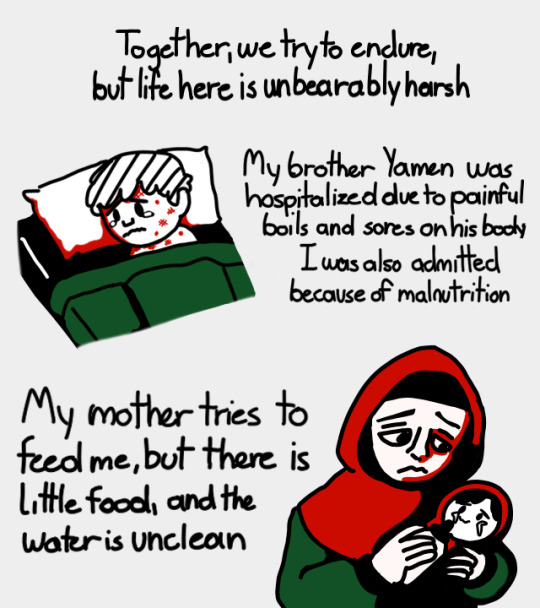

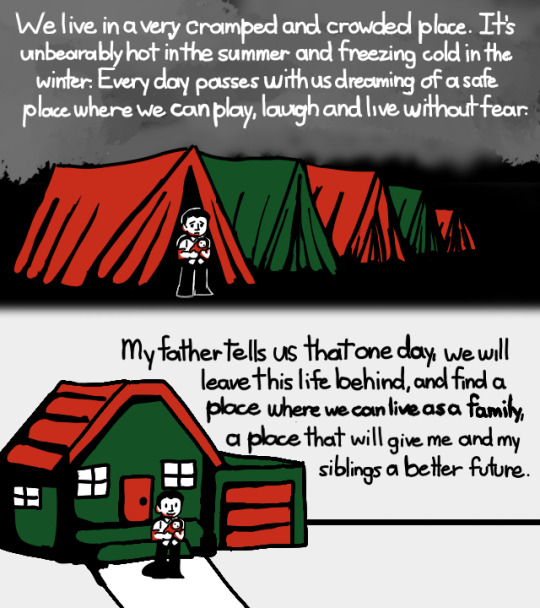


Our Story Through the Eyes of Ronza, the Six-Month-Old;
A story I drew for @zinaanqar
Ronza is the youngest child of Dina and Ahmed Alanqar, born amidst the Gaza's devestation. In all of the six months that she has lived so far, she has never known a day without the threat of weather, disease or explosions. Nobody should live this life, especially not a little baby.
But you can change that for her. You can donate just €5, and it will help this little girl and her family get a chance at a new beginning.
Even if you cannot donate, sharing this around will be a great asset in saving the lives of the Alanqar family
DONATION LINK
VERIFICATION LINK (264)
€83,248/€100,000 as of Dec 24th
8K notes
·
View notes
Text


wish my phone took a better picture here I love these guys and their funny butts
Pretty sure it's a Spined Micrethina (all the micrethinas have distinct abdomens)
0 notes
Text

Very Handsome dragonfly~
0 notes
Text


Robber flies caught in the act >:O
0 notes
Text

Lost in that thistle sauce
0 notes
Text
The Vampire Moth: these moths use a specialized proboscis to pierce the skin on pieces of fruit and feed on the juices inside, but some have also been observed using the same tactic to feed on human blood
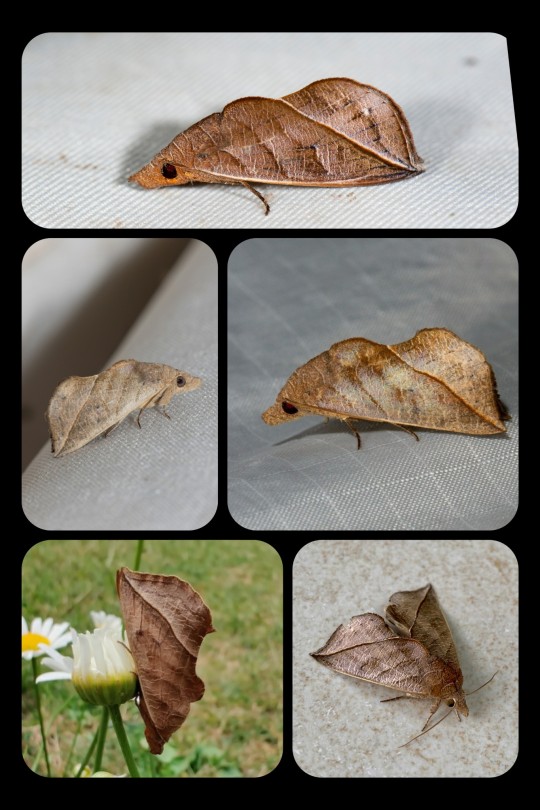
Members of the genus Calyptra are often collectively referred to as "Vampire Moths." All members of this genus are obligate fruit-piercers, meaning that they all subsist primarily on fruit, and they must use their proboscis to pierce through the skin -- but 10 species of Calyptra (out of 18 species in total) have also been documented using the same technique to feed on the blood of living vertebrates, and some are even known to feed on humans.
Blood-feeding (i.e. hematophagy) seems to occur only among the adult males. In various cases, vampire moths have been known to feed on the blood of pigs, antelope, water buffalo, deer, tapir, cattle, elephants, and humans (among other things). Before it can feed, the moth must press its proboscis against the surface of the skin and then oscillate its head back and forth until it is able to pierce through the skin.
Then, according to an article in Entomology Today:
As blood from the host animal wells up, it opens hooks on the sides of the proboscis to anchor it firmly. The proboscis has two parts that alternate between anchoring and drilling through host tissue using an “antiparalell” movement. A bite from a Calyptra moth is red and sore, but is believed to pose no danger to human beings. A vampire moth can suck blood for up to 50 minutes.
Calyptra is a widely distributed genus, with species appearing on most continents, but blood-feeding only seems to occur within the Calyptra populations in South/Southeast Asia and North/Eastern Russia. Some species have been known to feed on blood within certain parts of their geographical range, while feeding only on fruit throughout the rest of their habitat. It's widely speculated that differences in elevation, precipitation, and/or other macroclimate conditions may have an effect on those behaviors.
The biological purpose of blood-feeding among vampire moths is not known, but many scientists theorize that it may allow the males to supplement their salt intake in order to produce healthier offspring.
Calyptra moths are also excellent leaf mimics; their wings are patterned/textured much like dry leaves, enabling them to remain camouflaged when their wings are folded.
Sources/More Info
Purdue University: Investigations of the Vampire Moth Genus Calyptra (PDF)
Entomological Society of America: Geographic Distribution and Differential Feeding Behaviors of the Fruit-Piercing and Skin-Piercing Moth, Calyptra thalictri
Science Direct: Wound-Feeding and Skin-Piercing Moths
Entomology Today: Vampire Moths Suck the Blood of Vertebrates, Including Humans
The Daily Garden: Vampire Moths
Images: [1] C. orthograpta [2] C. minuticornis [3] C. minuticornis [4] C. thalictri [5] C. minuticornis
126 notes
·
View notes
Text
Poplar Lappet Moths: these moths are able to mimic the dead leaves of a poplar tree (there is at least one moth in each of the photos below)

Above: the photo at the top shows two poplar lappet moths disguised as foliage (the two "leaves" on the left-most end of the branch are actually moths) and the photo on the bottom shows another poplar lappet moth clinging to a leaf
The scientific name of this species is Gastropacha populifolia, but it's more commonly referred to as the poplar lappet moth. It's also known as pappelglucke in German and feuille-morte du peuplier in French.

The moths are distributed across large sections of Europe, Russia, China, Korea, and Japan, but they're regarded as a rare species throughout most of Europe.
The shape, color, wing pattern, and resting position of this species all contribute to its unique disguise, as it bears an uncanny resemblance to a dead leaf. It even has a dark, snout-like projection (the labial palpi) that mimics the stem of a leaf, and its wing pattern completes the illusion with a dark, raised line forming the central "vein" of the leaf; the soft ridges and scalloped edges of its wings also add to the effect.

There are many other leaf-mimicking moths out there, but this species is particularly impressive.

The caterpillars also have a knack for blending in -- thanks to their cryptic coloration and fuzzy, setae-lined sides, they are easily camouflaged against the bark of a poplar tree.

Above: the photos at the top show Gastropacha populifolia caterpillars blending in by pressing their bodies flat up against twigs/branches, and the photo at the bottom shows one of the caterpillars in a more conspicuous setting
These moths are defended by more than just mimicry, though; they can also produce ultrasonic clicks that interfere with the echolocation signals of predatory bats, which allows the moths to avoid being detected (and ultimately eaten) by bats.

Above: the adorable face of a poplar lappet moth
Sources & More Info:
Nota Lepidopterologica: Continuous Long-Term Monitoring of Daily Foraging Patterns in Three Species of Lappet Moth Caterpillars
Catalogue of the Lepidoptera of Belgium: Gastropacha populifolia
Moths and How to Rear Them: Gastropacha populifolia
Wikipedia (German): Pappelglucke
Moths and Butterflies of Europe and North Africa: G. populifolia
EurekaMag: Effect of the Scale Coverage of the Moth Gastropacha populifolia on the Reflection of Bat Echolocation Signals
265 notes
·
View notes
Text
Yellowjacket-Mimicking Moth: this is just a harmless moth that mimics the appearance and behavior of a yellowjacket/wasp; its disguise is so convincing that it can even fool actual wasps

This species (Myrmecopsis polistes) may be one of the most impressive wasp-mimics in the world. The moth's narrow waist, teardrop-shaped abdomen, black-and-yellow patterning, transparent wings, smooth appearance, and folded wing position all mimic the features of a wasp. Unlike an actual wasp, however, it does not have any mandibles or biting/chewing mouthparts, because it's equipped with a proboscis instead, and it has noticeably "feathery" antennae.
There are many moths that use hymenopteran mimicry (the mimicry of bees, wasps, yellowjackets, hornets, and/or bumblebees, in particular) as a way to deter predators, and those mimics are often incredibly convincing. Myrmecopsis polistes is one of the best examples, but there are several other moths that have also mastered this form of mimicry.

Above: Pseudosphex laticincta, another moth species that mimics a yellowjacket
These disguises often involve more than just a physical resemblance; in many cases, the moths also engage in behavioral and/or acoustic mimicry, meaning that they can mimic the sounds and behaviors of their hymenopteran models. In some cases, the resemblance is so convincing that it even fools actual wasps/yellowjackets.

Above: Pseudosphex laticincta
Such a detailed and intricate disguise is unusual even among mimics. Researchers believe that it developed partly as a way for the moth to trick actual wasps into treating it like one of their own. Wasps frequently prey upon moths, but they are innately non-aggressive toward their own fellow nest-mates, which are identified by sight -- so if the moth can convincingly impersonate one of those nest-mates, then it can avoid being eaten by wasps.

Above: Pseudosphex laticincta
I gave an overview of the moths that mimic bees, wasps, yellowjackets, hornets, and bumblebees in one of my previous posts, but I felt that these two species (Myrmecopsis polistes and Pseudosphex laticincta) deserved to have their own dedicated post, because these are two of the most convincing mimics I have ever seen.

Above: Pseudosphex sp.
I think that moths in general are probably the most talented mimics in the natural world. They have so many intricate, unique disguises, and they often combine visual, behavioral, and acoustic forms of mimicry in order to produce an uncanny resemblance.
Several of these incredible mimics have already been featured on my blog: moths that mimic jumping spiders, a moth that mimics a broken birch twig, a moth caterpillar that can mimic a snake, a moth that disguises itself as two flies feeding on a pile of bird droppings, a moth that mimics a dried-up leaf, a moth that can mimic a cuckoo bee, and a moth that mimics the leaves of a poplar tree.
Moths are just so much more interesting than people generally realize.
Sources & More Info:
Journal of Ecology and Evolution: A Hypothesis to Explain Accuracy of Wasp Resemblances
Entomology Today: In Enemy Garb: A New Explanation for Wasp Mimicry
iNaturalist: Myrmecopsis polistes and Pseudosphex laticincta
Transactions of the Entomological Society of London: A Few Observations on Mimicry
15K notes
·
View notes
Text

Very handsome bee on the milkweed vine. Plus a fly lol
0 notes
Text



June Beetle from last summer~
0 notes



